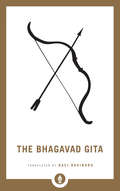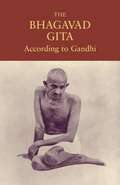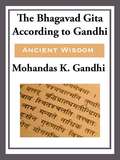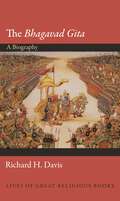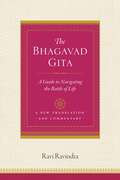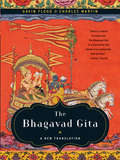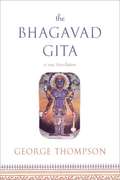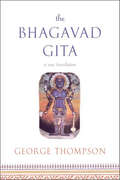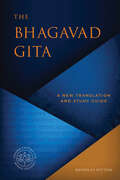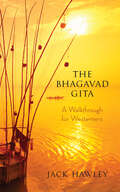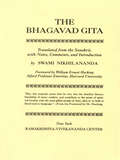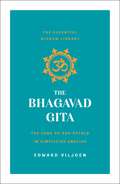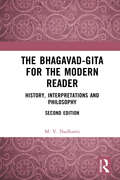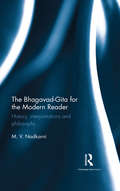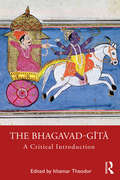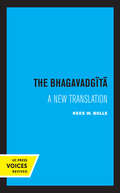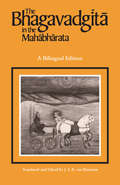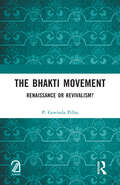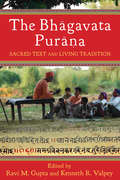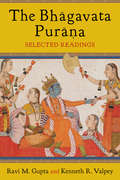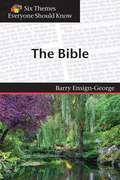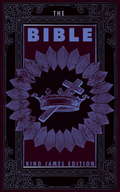- Table View
- List View
The Bhagavad Gita (Shambhala Pocket Library)
by Ravi RavindraA new translation of the great spiritual classic.Widely hailed as the single most important text to emerge from India, the Bhagavad Gita has inspired countless readers—sages, students, yogis, and seekers. A part of the great Hindu classic, the Mahābhārata, this text is presented as a dialogue between the skillful warrior Arjuna and the god Krishna, as Arjuna faces a crisis about dharma and prepares for a great battle with no defenses other than Krishna’s divine guidance.Dr. Ravindra’s fresh prose translation stands out from the many other versions by presenting the Bhagavad Gita as a call to action. It is at heart a universal guide to navigating the battle of life required of each and every one of us. The Bhagavad Gita: A Guide to Navigating the Battle of Life, from which this book derives, contains commentary from the translator, along with a selected bibliography and index.This book is part of the Shambhala Pocket Library series.The Shambhala Pocket Library is a collection of short, portable teachings from notable figures across religious traditions and classic texts. The covers in this series are rendered by Colorado artist Robert Spellman. The books in this collection distill the wisdom and heart of the work Shambhala Publications has published over 50 years into a compact format that is collectible, reader-friendly, and applicable to everyday life.
The Bhagavad Gita - A Walkthrough for Westerners
by Jack HawleyTranslation of a mystical poem that explains the piece's most difficult concepts. Describes healing inner pain and celebrating life.
The Bhagavad Gita According to Gandhi
by Mahatma GandhiThe Bhagavad Gita,also called The Song of the Lord,is a 700-line section of a much longer Sanskrit war epic, the Mahabharata, about the legendary conflict between two branches of an Indian ruling family. Framed as a conversation between Krishna, an incarnation of the god Vishnu, and a general of one of the armies, the Gita is written in powerful poetic language meant to be chanted.
The Bhagavad Gita According to Gandhi
by Mahatma GandhiThe Bhagavad Gita, also called The Song of the Lord, is a 700-line section of a much longer Sanskrit war epic, the Mahabharata, about the legendary conflict between two branches of an Indian ruling family. Framed as a conversation between Krishna, an incarnation of the god Vishnu, and a general of one of the armies, the Gita is written in powerful poetic language meant to be chanted. Equally treasured as a guide to action, a devotional scripture, a philosophical text, and inspirational reading, it remains one of the world's most influential, widely read spiritual books.The Bhagavad Gita According to Gandhi is based on talks given by Gandhi between February and November 1926 at the Satyagraha Ashram in Ahmedabad, India. During this time--a period when Gandhi had withdrawn from mass political activity--he devoted much of his time and energy to translating the Gita from Sanskrit into his native Gujarati. As a result, he met with his followers almost daily, after morning prayer sessions, to discuss the Gita's contents and meaning as it unfolded before him. This book is the transcription of those daily sessions.From the Trade Paperback edition.
The Bhagavad Gita According to Gandhi
by Mohandas K. GandhiMy first acquaintance with the Gita began in 1888-89 with the verse translation by Sir Edwin Arnold known as the Song Celestial. On reading it, I felt a keen desire to read a Gujarati translation. And I read as many translations as I could lay hold of. But all such reading can give me no passport for presenting my own translation. Then again my knowledge of Sanskrit is limited, my knowledge of Gujarati too is in no way scholarly. How could I then dare present the public with my translation? It has been my endeavor, as also that of some companions, to reduce to practice the teaching of the Gita as I have understood it. The Gita has become for us a spiritual reference book. I am aware that we ever fail to act in perfect accord with the teaching. The failure is not due to want of effort, but is in spite of it. Even though the failures we seem to see rays of hope. The accompanying rendering contains the meaning of the Gita message which this little band is trying to enforce in its daily conduct. --Mahatma Gandhi Wilder Publications is a green publisher. All of our books are printed to order. This reduces waste and helps us keep prices low while greatly reducing our impact on the environment.
The Bhagavad Gita: A Biography (Lives of Great Religious Books #23)
by Richard H. DavisThe life and times of India's most famous spiritual and literary masterpieceThe Bhagavad Gita, perhaps the most famous of all Indian scriptures, is universally regarded as one of the world's spiritual and literary masterpieces. Richard Davis tells the story of this venerable and enduring book, from its origins in ancient India to its reception today as a spiritual classic that has been translated into more than seventy-five languages. The Gita opens on the eve of a mighty battle, when the warrior Arjuna is overwhelmed by despair and refuses to fight. He turns to his charioteer, Krishna, who counsels him on why he must. In the dialogue that follows, Arjuna comes to realize that the true battle is for his own soul.Davis highlights the place of this legendary dialogue in classical Indian culture, and then examines how it has lived on in diverse settings and contexts. He looks at the medieval devotional traditions surrounding the divine character of Krishna and traces how the Gita traveled from India to the West, where it found admirers in such figures as Ralph Waldo Emerson, Henry David Thoreau, J. Robert Oppenheimer, and Aldous Huxley. Davis explores how Indian nationalists like Mahatma Gandhi and Swami Vivekananda used the Gita in their fight against colonial rule, and how contemporary interpreters reanimate and perform this classical work for audiences today.An essential biography of a timeless masterpiece, this book is an ideal introduction to the Gita and its insights into the struggle for self-mastery that we all must wage.
The Bhagavad Gita: A Guide to Navigating the Battle of Life (Shambhala Pocket Library #26)
by Ravi RavindraA new translation of the great classic--with wide-ranging, multi-traditional commentary that emphasizes its practical advice for living with integrity.“All there is is Krishna.” Upon hearing this famous and enigmatic line from the Gita’s seventh chapter when he was a boy, Ravi Ravindra embarked on a journey to understand its deep meaning. The search led him far beyond the tradition from which the text originally arose to an exploration of world mystical wisdom, including Zen, Christianity, Yoga, and particularly the teachings of J. Krishnamurti and G. I. Gurdjieff. Dr. Ravindra’s fresh prose translation with wide-ranging commentary, is the fruit of that lifelong process. It stands out from the many other versions with its assertion that the Bhagavad Gita is at heart a universal guide to navigating the battle of life required of each and every one of us. It is through that navigation, he shows, that we can discover and connect with the Krishna deep within ourselves: The Eternal Witness who is above the battle, and who is, ultimately and joyfully, all there is.
The Bhagavad Gita: A New Translation
by Charles Martin Gavin FloodThe Bhagavad Gita, the Song of the Lord, is an ancient Hindu scripture about virtue, presented as a dialogue between Krishna, an incarnation of God, and the warrior Arjuna on the eve of a great battle over succession to the throne. This new verse translation of the classic Sanskrit text combines the skills of leading Hinduist Gavin Flood with the stylistic verve of award-winning poet and translator Charles Martin. The result is a living, vivid work that avoids dull pedantry and remains true to the extraordinarily influential original. A devotional, literary, and philosophical masterpiece of unsurpassed beauty and imaginative relevance, The Bhagavad Gita has inspired, among others, Mahatma Gandhi, J. Robert Oppenheimer, T. S. Eliot, Christopher Isherwood, and Aldous Huxley. Its universal themes--life and death, war and peace, sacrifice--resonate in a West increasingly interested in Eastern religious experiences and the Hindu diaspora.
The Bhagavad Gita: A New Translation
by George ThompsonThe Bhagavad Gita, a small section of the massive Sanskrit epic the Mahabharata, is one of the central texts of Indian culture and philosophy, and one of the great works of world literature. It has been translated into English many times since 1785, and has had a profound influence in America, beginning with the transcendentalists and continuing today. It is taught in introductory world literature, religion, and Eastern religion courses, and is often prescribed in yoga teacher training courses because it explains the core principles of Vedic philosophy, which are central to yoga practice. <p><p>Some of the currently available translations are in verse and, while well crafted, often do not accurately reflect the forms, sounds, and rhythms of the original. Older scholarly translations convey little feel for language. George Thompson's intention is to be as accurate and engaging as possible, and to create a translation that has scholarly bona fides, literary sensibility, and greater accuracy than previous translations. He emphasizes the social, historical, literary, and philosophical contexts surrounding the text. His introduction explains the development of Hindu thought and where the philosophy of the "Gita" fits historically, along with a history of the text and its place in Indian literature, philosophy, and history. <P><P><i>Bookshare Note: Page numbers in this book are offset by 48. For page 10 in the table of contents, please go to page 58 for example.</i>
The Bhagavad Gita: A New Translation
by George ThompsonA fresh, new prose translation of the classic Indian poem, ideally focused for students and teachers and for yoga teacher training The Bhagavad Gita, a small section of the massive Sanskrit epic the Mahabharata, is one of the central texts of Indian culture and philosophy, and one of the great works of world literature. It has been translated into English many times since 1785, and has had a profound influence in America, beginning with the transcendentalists and continuing today. It is taught in introductory world literature, religion, and Eastern religion courses, and is often prescribed in yoga teacher training courses because it explains the core principles of Vedic philosophy, which are central to yoga practice.Some of the currently available translations are in verse and, while well crafted, often do not accurately reflect the forms, sounds, and rhythms of the original. Older scholarly translations convey little feel for language. George Thompson's intention is to be as accurate and engaging as possible, and to create a translation that has scholarly bona fides, literary sensibility, and greater accuracy than previous translations. He emphasizes the social, historical, literary, and philosophical contexts surrounding the text. His introduction explains the development of Hindu thought and where the philosophy of the "Gita" fits historically, along with a history of the text and its place in Indian literature and philosophy and history..
The Bhagavad Gita: A New Translation and Study Guide (Tiny Book Ser.)
by Nicholas SuttonThis short course sets out a detailed study of the text, philosophy, and contemporary significance of the teachings found within this ancient sacred book.The Bhagavad Gita, which was spoken perhaps five thousand years ago and whose written form has been extant for over two thousand years, continues to inspire new generations of seekers in the East and West. Gandhi in the East and Thoreau, Emerson, Einstein, and others in the West found within its pages deep wisdom, comfort, and contemporary applications to their lives and times. The Gita ranks with the Bible, Dhammapada, Dao De Jing, Qu’ran, and other significant sacred books as a universal source teaching that transcends sectarian religions. In addition, the Bhagavad Gita—along with the Yoga sutras—is one of the two primary foundational books on the yoga path, aspects of which have become wildly popular in the West in recent decades.This new translation and commentary on the Gita is the first in a series produced by the Oxford Centre of Hindu Studies (OCHS), a Recognised Independent Centre of the University of Oxford. The OCHS Gita is simultaneously authoritative, academically sound, and accessible for inquiring students and seekers. Each chapter has an English translation of the verses, explores main themes, and explains how the knowledge is relevant and applicable to our twenty-first-century world.
The Bhagavad Gita: A Walkthrough for Westerners
by Jack HawleyThe Bhagavad Gita has been called India's greatest contribution to the world. For more than five thousand years, this great scripture has shown millions in the East how to fill their lives with serenity and love. In these pages, Jack Hawley brings these ancient secrets to Western seekers in a beautiful prose version that makes the story of the Gita clear and exciting, and makes its truths understandable and easy to apply to our busy lives. The Gita is a universal love song sung by God to His friend man. It can't be confined by any creed. It is a statement of the truths at the core of what we all already believe, only it makes those truths clearer, so they become immediately useful in our daily lives. These truths are for our hearts, not just our heads. The Gita is more than just a book, more than mere words or concepts. There is an accumulated potency in it. To read the Gita is to be inspired in the true sense of the term: to be “inspirited,” to inhale the ancient and ever-new breath of spiritual energy.
The Bhagavad Gita: Song of the Lord
by Swami NikhilanandaWith introduction to the Gita, summary of the Mahabharata and notes based on commentary of Sankaracharya. "The first really readable, authoritative English translation of one of the world's greatest religious classics." --Time Magazine.
The Bhagavad Gita: The Song of God Retold in Simplified English (The Essential Wisdom Library) (The Essential Wisdom Library)
by Edward ViljoenThe Bhagavad Gita: The Song of God Retold in Simplified English is the latest title in the Essential Wisdom Library. This unique edition of the timeless epic is designed to be accessible for readers without any prior experience of Hinduism. Not simply a translation of the original, Viljoen has simplified and restated the Gita’s complex ideas, so that a first-time reader can fully appreciate the scope and beauty of this magnificent Indian classic. Written in concise, modern language the retelling vividly captures the power and depth of the original work.Part of the Mahabharata, the Gita is a dialogue between Prince Arjuna and Lord Krishna. Its verses contain some of the key ideas of Hindu philosophy—Dharma, Moksha, and various yogic practices. Originally written well over a thousand years ago, the Gita has proven to be a timeless source of wisdom, inspiring philosophers and revolutionaries alike in the millennia since it was written. In addition to the retelling of the text, this edition includes a character list, a glossary of important terms, and chapters exploring the back-story from the Mahabharata and the impact and meaning of the Bhagavad Gita itself. The Bhagavad Gita is an approachable way for today’s readers to engage with one of history's richest spiritual epics.
The Bhagavad-Gita for the Modern Reader: History, Interpretations and Philosophy
by M. V. NadkarniWhat is the Bhagavad-Gita? Is it just a religious text? When was it composed? How relevant is it to the modern world? This book answers these foundational questions and more. It critically examines the Bhagavad-Gita in terms of its liberal, humanist and inclusive appeal, bringing out its significance for both present times and novel applications. The author elaborates the philosophy underlying the text as well as its ethical and spiritual implications. He also responds to criticisms that have been levelled against the text by Ambedkar, D. D. Kosambi and, more recently, Amartya Sen. With additional material including chapter summaries of the Bhagavad-Gita, the second edition of the volume proposes new ways of utilising the text in diverse fields, such as business and management and scientific research. Eclectic and accessible, this work will be of interest to scholars of philosophy, religion, history, business and management studies, as well as the general reader.
The Bhagavad-Gita for the Modern Reader: History, interpretations and philosophy
by M. V. NadkarniWhat is the Bhagavad-Gita? Is it just a religious text? When was it composed? How relevant is it to the modern world? This book answers these foundational questions and goes beyond. It critically examines the Bhagavad-Gita in terms of its liberal, humanist and inclusive appeal, bringing out its significance for the present times and novel applications. The author elaborates the philosophy underlying the text as also its ethical, spiritual and moral implications. He also responds to criticisms that have been levelled against the text by Ambedkar, D. D. Kosambi, and more recently, Amartya Sen. The volume proposes unique bearings of the text in diverse fields such as business & management and scientific research. Eclectic and accessible, this work will be of interest to scholars of philosophy, religion, history, business & management studies as well as the general reader.
The Bhagavad-gītā: A Critical Introduction
by Ithamar TheodorThis volume is a systematic and comprehensive introduction to one of the most read texts in South Asia, the Bhagavad-gītā. The Bhagavad-gītā is at its core a religious text, a philosophical treatise and a literary work, which has occupied an authoritative position within Hinduism for the past millennium. This book brings together themes central to the study of the Gītā, as it is popularly known – such as the Bhagavad-gītā’s structure, the history of its exegesis, its acceptance by different traditions within Hinduism and its national and global relevance. It highlights the richness of the Gītā’s interpretations, examines its great interpretive flexibility and at the same time offers a conceptual structure based on a traditional commentarial tradition. With contributions from major scholars across the world, this book will be indispensable for scholars and researchers of religious studies, especially Hinduism, Indian philosophy, Asian philosophy, Indian history, literature and South Asian studies.
The Bhagavadgita
by Kees BolleThis title is part of UC Press's Voices Revived program, which commemorates University of California Press’s mission to seek out and cultivate the brightest minds and give them voice, reach, and impact. Drawing on a backlist dating to 1893, Voices Revived makes high-quality, peer-reviewed scholarship accessible once again using print-on-demand technology. This title was originally published in 1979.
The Bhagavadgita in the Mahabharata
by J. A. van BuitenenNo other Sanskrit work approaches the Bhagavadgita in the influence it has exerted in the West. Philosophers such as Emerson and the other New England Transcendentalists were deeply affected by its insights, a dozen or more scholars, including Annie Besant and Mahatma Gandhi, have attempted its translation, and thousands of individuals struggling with the problems divided loyalties have found comfort and wisdom in its pages. The Bhagavadgita ("Song of the Lord") tells of the young and virtuous Prince Arjuna who is driven to lead his forces into battle against an opposing army composed of close relatives and others whom he loves. The Lord Krsna, appearing in the poem as Arjuna's friend and charioteer, persuades him that he must do battle, and we see Arjuna changing from revulsion at the thought of killing members of his family to resignation and awareness of duty, to manly acceptance of his role as warrior and defender of his kingdom. The Bhagavadgita is a self-contained episode in the Mahabharata, a vast collection of epics, legends, romances, theology, and metaphysical doctrine that reflects the history and culture of the whole of Hindu civilization. The present edition forms a part of J. A. B. van Buitenen's widely acclaimed translation of this great work. Here English and Sanskrit are printed on facing pages, enabling those with some knowledge of Sanskrit to appreciate van Buitenen's accurate rendering of the intimate, familial tone and directness of the original poem.
The Bhakti Movement: Renaissance or Revivalism?
by P. Govinda PillaiThis is a Comprehensive Survey of the Bhakti Movement as it sprang in South India to spread across the subcontinent in independent and multifarious manifestations yet marked with amazing commonalities. Spanning a period of 11 centuries starting from the 6th CE, the movement encompassed in its sweep a vast range of dimensions; Social, political, economic, religious, cultural, linguistic, ethical and philosophical. Among the multifarious movements which contributed to the formation of India and its Culture, the Bhakti was undoubtedly the most pervasive and persistent, says the author. Besides its sweep and depth, what proved most remarkable about the movement was that it arose almost everywhere from the masses who belonged to the lowest class and castes. Though spirituality was its leitmotif, Bhakti proved to be a stirring song of the subaltern in their varied expressions of resistance and revolt. A seemingly conservative phenomenon became a potent weapon against entrenched hierarchies of orthodoxy and oppression, in a wonderful dialectical expression. This qualifies Bhakti movement to be reckoned on a par with European renaissance as it marked a massive upsurge in the societal value system to directly impact a range of fields like arts, politics, culture or religion. Even as he takes note of the elements of reactionary revivalism that also marked the Bhakti movement, the author convincingly argues that those of renaissance and progress far outweighed the former.
The Bhāgavata Purāna: Sacred Text and Living Tradition
by Ravi Gupta Kenneth ValpeyA vibrant example of living literature, the Bhagavata Purana is a versatile Hindu sacred text written in Sanskrit verse. Finding its present form by the tenth century C.E., the work inspired several major north Indian devotional (bhakti) traditions as well as schools of dance and drama, and continues to permeate popular Hindu art and ritual in both India and the diaspora. Introducing the Bhagavata Purana's key themes while also examining its extensive influence on Hindu thought and practice, this collection conducts the first multidimensional reading of the entire text. Each essay focuses on a key theme of the Bhagavata Purana and its subsequent presence in Hindu theology, performing arts, ritual recitation, and commentary. The authors consider the relationship between the sacred text and the divine image, the text's metaphysical and cosmological underpinnings, its shaping of Indian culture, and its ongoing relevance to contemporary Indian concerns.
The Bhāgavata Purāna: Selected Readings
by Ravi Gupta Kenneth ValpeyFormalized by the tenth century, the expansive Bhagavata Purana resists easy categorization. While the narrative holds together as a coherent literary work, its language and expression compete with the best of Sanskrit poetry. The text's theological message focuses on devotion to Krishna or Vishnu, and its philosophical outlook is grounded in the classical traditions of Vedanta and Samkhya. No other Purana has inspired so much commentary, imitation, and derivation. The work has grown in vibrancy through centuries of performance, interpretation, worship, and debate and has guided the actions and meditations of elite intellectuals and everyday worshippers alike. This annotated translation and detailed analysis shows how one text can have such enduring appeal. Key selections from the Bhagavata Purana are faithfully translated, while all remaining sections of the Purana are concisely summarized, providing the reader with a continuous and comprehensive narrative. Detailed endnotes explain unfamiliar concepts and several essays elucidate the rich philosophical and religious debates found in the Sanskrit commentaries. Together with the multidisciplinary readings contained in the companion volume The Bhagavata Purana: Sacred Text and Living Tradition (Columbia, 2013), this book makes a central Hindu masterpiece more accessible to English-speaking audiences and more meaningful to scholars of Hindu literature, philosophy, and religion.
The Bible
by Barry Ensign-GeorgeEnsign-George looks at six themes that begin in the early chapters of Genesis, span the pages of Scripture, and end with the glorious vision of the book of Revelation. This study is important for discussing basic biblical frameworks. Within Scripture, echoes of early themes are picked up and heard, leading to deeper appreciation of the biblical message.
The Bible
by Random HouseOriginally produced for the Church of England, The King James Version is one of the most enduring translations of The Bible. It's combination of poeticism and readability have made it the most prominent version of the best-selling book in human history. Penguin Random House Canada is proud to bring you classic works of literature in e-book form, with the highest quality production values. Find more today and rediscover books you never knew you loved.
